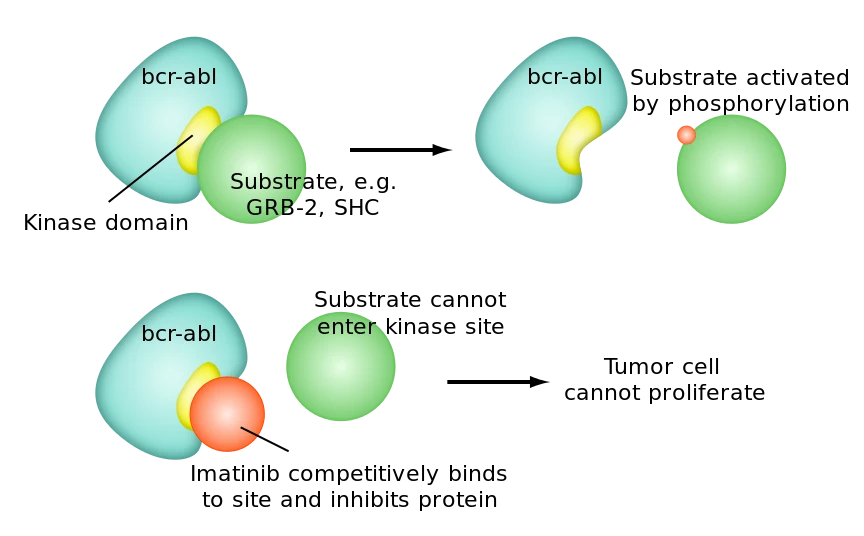Revolutionizing Medicine: The Remarkable Stories of Imatinib and Oseltamivir
Written by Amélie Lagacé-O'Connor | Published 2023-7-26
Written by Amélie Lagacé-O'Connor | Published 2023-7-26
In the dynamic landscape of medicine, breakthrough drugs hold the power to reshape lives and redefine treatments. Meet Imatinib and Oseltamivir, two remarkable pharmaceuticals that have taken the medical realm by storm. Imatinib, commonly known as Gleevec or Glivec, revolutionized the battle against chronic myeloid leukemia (CML), while Oseltamivir, or Tamiflu, is an important defender against the seasonal influenza virus. Join us as we go through the remarkable mechanisms of these drugs and discover how cutting-edge technology paved the way for their discoveries.
Imatinib, commonly known as Gleevec or Glivec, has emerged as an oral targeted drug used to treat chronic myeloid leukemia (CML). Conceived by researchers in the late 1990s, this ground-breaking drug received medical approval in the United-States in 2001. At the heart of its efficacy lies a remarkable mechanism of action—targeting and inhibiting the BCR-ABL fusion protein found in CML patients. This mutated protein belongs to the family of tyrosine kinases, essential proteins that add phosphate groups to specific residues on certain proteins, governing vital signaling pathways for cell growth, differentiation, and survival. In the context of the BCR-ABL protein, this tyrosine kinase remains constitutively active, instigating a cascade of downstream signaling events causing uncontrolled cell proliferation without apoptosis. Undoubtedly, this molecular aberration significantly contributes to the development and progression of chronic myeloid leukemia, making Imatinib a remarkable ally in the battle against this formidable disease.
Imatinib operates by selectively binding to the ATP-binding site of the BCR-ABL protein and disrupting its activity. This specificity not only halts the growth of the cancerous cells but also mitigates the negative impact on normal cells, establishing it as a highly effective and well-tolerated drug for CML patients worldwide. In a 2020 article, Breccia explains that many studies have proven Imatinib’s ability to improve the overall survival rate of patients with CML. With its targeted approach and proven outcomes, Imatinib stands as a beacon of hope in the fight against CML.

Oseltamivir, marketed as Tamiflu, was discovered in 1995 and received FDA approval in 1999 as a potent treatment for the seasonal flu, commonly known as influenza. Influenza viruses can be categorized into three main types: influenza A, influenza B, and influenza C. While these types can be further divided into subtypes, we’ll focus our attention on influenza A and B, as Oseltamivir was precisely tailored to combat them. The influenza virus primarily targets the nose, throat, and, at times, the lungs. Upon infiltrating the body, the virus attaches to cells lining the respiratory tract by binding to receptors on the surface of these cells, gaining entry to infect them. Once inside the host cell, the virus hijacks the cell’s machinery, orchestrating the replication of its genetic material and generating more viral particles, ultimately leading to the death of the infected cells, and further spread into other cells. In response to this invasion, our bodies activate natural defenses, like white blood cells, striving to restrict the virus’s spread. Simultaneously, a natural inflammatory response is triggered, resulting in familiar symptoms like a sore throat, cough, runny nose, and sneezing. Yet, at times, this immune response can be too aggressive, causing harm to healthy tissue. Moreover, this virus can weaken the respiratory tract’s defenses, making it easier for other bacteria to cause secondary infections like pneumonia.

Tamiflu, or Oseltamivir, operates as an antiviral medication designed to target the crucial enzymes on the influenza virus known as neuraminidases. By binding to the active site on these enzymes, Tamiflu effectively disrupts the virus’s ability to detach from the infected cell, leading to a significant reduction in its capacity to replicate. As a result of this action, the severity and duration of flu symptoms are noticeably diminished, offering much-needed relief to patients. Furthermore, Tamiflu plays an important role in minimizing the risks of complications that can come with having the flu, which are more prevalent in vulnerable populations such as the elderly population and individuals with compromised immune systems.

Both protein prediction and molecular docking technology played important roles in discovering and developing Gleevec and Tamiflu. In the case of Gleevec, researchers utilized X-ray crystallography to uncover the structure of the BCR-ABL protein. This technology assumed a pivotal role, guiding the drug’s development towards success. In a parallel pursuit, Tamiflu’s inception can also be accredited to this technology. By leveraging X-ray crystallography as well as techniques like cryo-electron microscopy (cryo-EM), scientists accurately predicted the three-dimensional structure of the neuraminidase enzyme of the influenza virus. Understanding the enzyme’s structure was paramount in designing a drug that could effectively inhibit its activity.
The development of these drugs also required the application of molecular docking technology. In the case of Gleevec, researchers used this technology to screen potential drug compounds capable of interacting with the BCR-ABL protein. They were able to identify that the drug compound Imatinib could bind to the ATP-binding pocket of the catalytic site of the BCR-ABL protein, as described by Gagic, Ruzic, Djokovic, Djikic, and Nikolic in 2019. Armed with this valuable information, they could then make informed decisions on chemical modifications to optimize the drug’s binding affinity and specificity. Similarly, in the case of Tamiflu, researchers used molecular docking technology after obtaining information on the structure of the neuraminidase enzyme to understand how it interacts with other proteins. This knowledge enabled them to design an optimized drug, effectively binding and inhibiting this critical enzyme, laying the foundation for a potent antiviral medication.
In the ever-evolving world of medicine, breakthrough drugs like Imatinib and Oseltamivir hold the power to reshape lives and redefine treatments. Imatinib, a game-changer in the battle against chronic myeloid leukemia, and Oseltamivir, a defender against seasonal influenza, have revolutionized medical treatments and offered hope to countless patients worldwide. Through this journey, we witnessed the incredible mechanisms behind these drugs, powered by protein prediction and molecular docking technology. As we continue to use such incredible technology, we push the boundaries of medical research, unlocking more transformative discoveries that will shape the future of healthcare for generations to come.
By Keaun Amani
By Keaun Amani
By Amélie Lagacé-O'Connor
By Danial Gharaie Amirabadi
By Keaun Amani
By Keaun Amani
Register for free — upgrade anytime.
Interested in getting a license? Contact Sales.
Sign up free